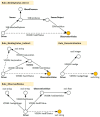A Context-Aware S-Health Service System for Drivers
- PMID: 28304330
- PMCID: PMC5375895
- DOI: 10.3390/s17030609
A Context-Aware S-Health Service System for Drivers
Abstract
As a stressful and sensitive task, driving can be disturbed by various factors from the health condition of the driver to the environmental variables of the vehicle. Continuous monitoring of driving hazards and providing the most appropriate business services to meet actual needs can guarantee safe driving and make great use of the existing information resources and business services. However, there is no in-depth research on the perception of a driver's health status or the provision of customized business services in case of various hazardous situations. In order to constantly monitor the health status of the drivers and react to abnormal situations, this paper proposes a context-aware service system providing a configurable architecture for the design and implementation of the smart health service system for safe driving, which can perceive a driver's health status and provide helpful services to the driver. With the context-aware technology to construct a smart health services system for safe driving, this is the first time that such a service system has been implemented in practice. Additionally, an assessment model is proposed to mitigate the impact of the acceptable abnormal status and, thus, reduce the unnecessary invocation of the services. With regard to different assessed situations, the business services can be invoked for the driver to adapt to hazardous situations according to the services configuration model, which can take full advantage of the existing information resources and business services. The evaluation results indicate that the alteration of the observed status in a valid time range T can be tolerated and the frequency of the service invocation can be reduced.
Keywords: context awareness; customized business services; driver health; semantic sensor network (SSN); situation assessment; smart health.
Conflict of interest statement
The authors declare no conflict of interest.
Figures










Similar articles
-
Implementation of safety driving system using e-health and telematics technology.Telemed J E Health. 2008 Aug;14(6):598-605. doi: 10.1089/tmj.2007.0083. Telemed J E Health. 2008. PMID: 18729761
-
Estimation of Driver's Danger Level when Accessing the Center Console for Safe Driving.Sensors (Basel). 2018 Oct 10;18(10):3392. doi: 10.3390/s18103392. Sensors (Basel). 2018. PMID: 30309040 Free PMC article.
-
The driver's instantaneous situation awareness when the alarm rings during the take-over of vehicle control in automated driving.Traffic Inj Prev. 2022;23(8):478-482. doi: 10.1080/15389588.2022.2122714. Epub 2022 Sep 28. Traffic Inj Prev. 2022. PMID: 36170041
-
The influence of distraction and driving context on driver response to imperfect collision warning systems.Ergonomics. 2007 Aug;50(8):1264-86. doi: 10.1080/00140130701318749. Ergonomics. 2007. PMID: 17558669 Review.
-
Visual attention and the transition from novice to advanced driver.Ergonomics. 2007 Aug;50(8):1235-49. doi: 10.1080/00140130701318707. Ergonomics. 2007. PMID: 17558667 Review.
Cited by
-
Advanced e-Call Support Based on Non-Intrusive Driver Condition Monitoring for Connected and Autonomous Vehicles.Sensors (Basel). 2021 Dec 10;21(24):8272. doi: 10.3390/s21248272. Sensors (Basel). 2021. PMID: 34960361 Free PMC article.
References
-
- Yang J.-J., Li J., Mulder J., Wang Y., Chen S., Wu H., Wang Q., Pan H. Emerging information technologies for enhanced healthcare. Comput. Ind. 2015;69:3–11. doi: 10.1016/j.compind.2015.01.012. - DOI
MeSH terms
LinkOut - more resources
Full Text Sources
Other Literature Sources
Research Materials

